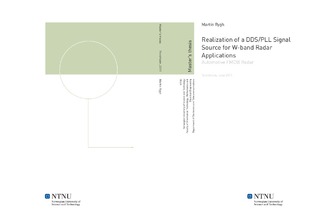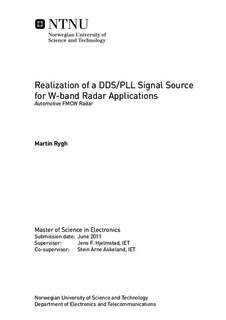| dc.description.abstract | This thesis presents a realization process, of how a programmable DDS/PLL signalsource were made suitable as an linear FMCW waveform generator for automotiveW-band radar applications. The dissertation describes the specific background theorythat were used to complete the implementation and substantiate the discoveries duringthe development process. Hence is an outline of FMCW basic properties, automotiveradar implementations, applied waveforms and the fundamental radar ambiguity functionpresented and threated. Moreover are vital background theory for basic FMCW designproblems presented, including degradation of range resolution due to loss of effectivebandwidth, nonlinearities in chirp modulation and limitations of the receiver resolution.Additionally is the inevitable problem of FMCW transceiver noise leakage briefly described, along with the general concept of choosing the right beat frequency for maximal FMCW sensitivity and maximal range-Doppler resolution. The specific circuit design is then presented, together with the full radar design which the signal source is intended for. The realization process starts with an initial test of circuit performance, seen in relation to the radar documentation and set the fundament for the further investigation and development. Hence does this part include measurements and discussion of output power achievements, spectral purity, spectral waveform appearance and phase noise. The thesis does then set further focus to more specific methods of measuring and evaluating the circuits LFM waveform, in aspect of a combined frequency and time characterization, chirp linearity achievements and waveform beat frequency evaluation. The dissertation does further describe how the first hand waveform generation were erroneous and how this problem was investigated and solved through radar documentation/source code corrections. As a last part of the realization process is then the final and successive implementation of waveforms described, along with the main results presented as waveform spectrograms and selected beat frequency spectrum plots. The working process and the main results are then summarized in a final summary discussion. The major results and conclusions of the thesis are that the tested NORBIT DDS/PLLsignal source could be realized as an linear FMCW waveform generator with overallgood linear properties. Two basic LFM waveforms, the up-chirp and triangular waveformwere implemented and tested. However were there discovered nonlinearities withinthe up-chirp waveform, due to the transient response of the total circuit. Hence mostlikely caused by the limited PLL frequency lock time. This was proven through aspecific beat frequency analysis of the most affected waveform, with fitted W-band LFMcharacteristics. Nevertheless were the isolated chirp generation within the waveformsconsidered more than sufficient, since both windowing technics and selective samplingcould be used in the future radar implementation. Three specific waveform realizationswere specially recommended for the initial further use. Further were also a specific region of desirable waveform chirp-rates recommended, that enables a good trade off between close target radar sensitivity and digital acquisition system complexity. Additionally did the thesis work conclude with that the NORBIT signal source design, enabled a flexible and easy control of the waveform generation through the microcontroller interface. Further more had also the thesis work resulted in the implementation of two good methods for waveform measurements and analysis. By the use of the spectrogram- and the beat frequency-method, could accurate waveform properties be extracted. Hence were also these methods recommended for further waveform developments in the experimental radar project.Furthermore was it recommended that future effort should be put in to the developmentof more applicable waveforms, to achieve full multiple range-Doppler target extraction.Hence since the overall signal source proved to have the nessesary waveform agility.It was in addition proposed that the future full radar implementation should utilizethe accessabillity of the microcontroller to achieve synchronization of signal sourcemodulation and future sampling solution. Thus to enable beneficial beat frequencysampling for the quadrature radar receiver. Since the mapping of the phase noiseinfluence and the chirp linearity were seen as non-optimal, was it additionally suggested that future studies should yield better methods for such characterization. It was finally put forward that an intermediate simple test radar could be implemented to enable sampling system testing and FMCW signal processing of real measurements, if the millimeter partof the radar is further postponed. | nb_NO |

